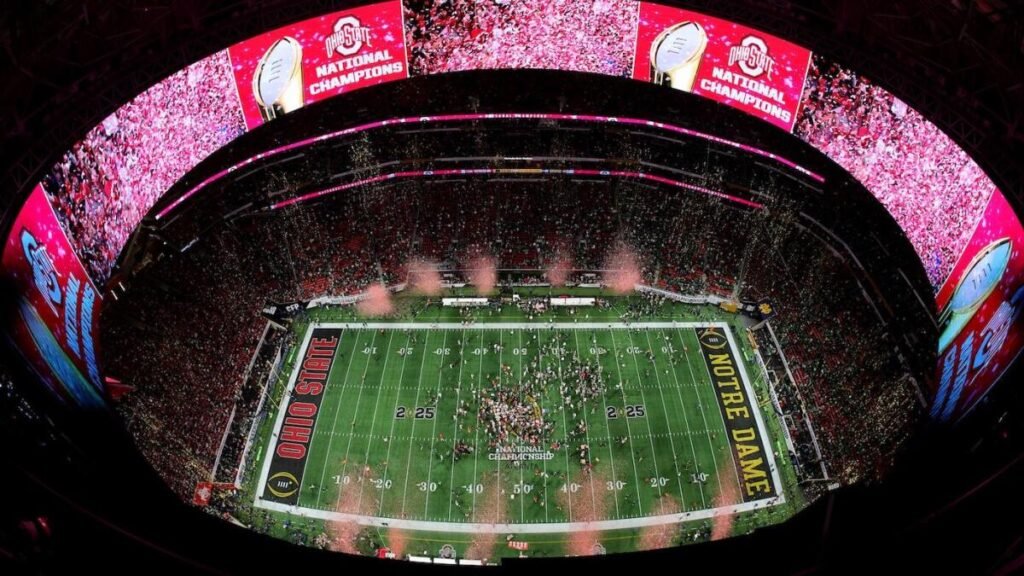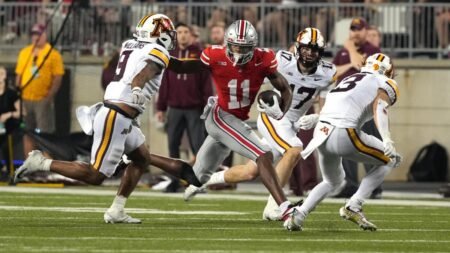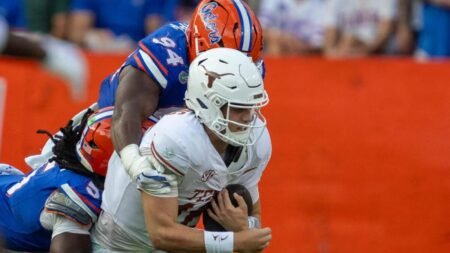Sports betting is everywhere now, and there’s no sport Americans love betting on more than football. Frankly, if it weren’t for Americans’ love of betting on football since the dawn of time (homo erectus made a living as a bookie at the local watering hole), it wouldn’t be legal in the first place.
Still, while it’s now legal and can be done on your phone as easily as sending a text, not everybody has dipped their toes into the water. If that’s you, and you’re considering trying it out this fall, you’re the person I’m writing this for.
If you don’t know what you’re doing, downloading a sports betting app and looking at everything that’s available can be intimidating if you don’t know what you’re doing, but don’t worry — nearly everybody doing it doesn’t know what they’re doing, either. This is a handy little betting guide to help teach you some of the absolute basics; it is not a guide to winning money betting on sports.
College football betting power rankings: Proven expert shares top teams ahead of 2025 season
Thomas Casale
Sorry for those of you who came upon this story thinking it would hold the secrets to being a sports betting success. It doesn’t. Trust me, if I knew how, I wouldn’t be writing this. I’d be too busy figuring out how to store all my winnings in different tax shelters around the world. The truth is, most people don’t win money betting on sports, even though every one of your friends says they do. Unless you plan on doing this professionally, which consumes far more of your time than you realize, the goal should be to win some bets and have fun.
My hope is that this guide helps you achieve those goals.
All stats and trends according to TruMedia
The basics
What can you bet in college football? While sportsbooks will offer prop bets on players and game-time situations during the season, those are more difficult to master, particularly if one does not understand the basics. The bread and butter of college football betting consists of the point spread (or “spread”), the total and the moneyline.
The spread: The most popular bet, the spread is the number of points given to a team to handicap a game with two equally likely outcomes. For example: in Week 0, Kansas State and Iowa State are squaring off in Ireland. The spreads, according to FanDuel, are listed as Kansas State -3.5 vs. Iowa State +3.5. The easiest way to think about this is the game starts with Iowa State receiving a 3.5-point lead. Suppose you bet Kansas State -3.5, the Wildcats need to win by at least four points for you to win your bet. If you bet Iowa State, you win your bet if the Cyclones win outright or lose by three points or fewer. While this spread includes a half-point to make sure there’s no tie, that’s not always the case. If the spread was 3 and the game ended with a 3-point margin, your bet would be graded a “push” and your money would be refunded.
The total: This represents the total points scored in the game. The listed total for the same Kansas State-Iowa State game is 49.5 points. You can bet on the over or under. If you think more than 49.5 points will be scored in the game, you bet the over 49.5. If you think there will be fewer, you bet the under 49.5. Pretty straightforward, isn’t it?
The moneyline: This is the simplest bet because you’re picking who will win the game outright. The math isn’t straightforward, however. As a 3.5-point favorite, Kansas State is clearly expected to win more often, which is why it’s listed at (-156) on the moneyline. Iowa State is at (+130). That means the payouts will differ depending on which side you choose.
A simple way to go about it is to think in $100 bets: To win $100 betting Kansas State at (-156), you must risk $156. Conversely, a $100 bet on Iowa State (+130) would win you $130 if the Cyclones pull off the upset. You are paying the price, given the likelihood of your chosen outcome occurring.
Another way to think about it: If the odds are (-156), divide one by 1.56 and you get 0.64, which means you will win 64 cents for every dollar you risk. If you have plus odds, like Iowa State at (+130), multiply one by 1.30. You win $1.30 for every dollar you risk.
Odds: Moneylines are not the only bets with odds attached to them. Spread and total bets have odds as well. Using the same game as the example, Kansas State -3.5 is listed with (-110) attached. Iowa State +3.5 also has (-110), as do both sides of the total. This is called the “juice” or “vigorish” (aka “vig”). Essentially, it’s how much the sportsbook charges you for the ability to make a bet. While -110 is standard, the odds can fluctuate for spreads and totals depending on various factors. Like the moneyline, with -110 juice you have to bet $110 to win $100, and you will win .91 cents (1/1.1) for every dollar you risk. Another factor you must consider, though, is implied odds.
Implied odds
The simplest way to think of implied odds is how often you have to win a particular bet to make money. The math is simple. If the odds are a negative number, remove the negative and add 100 to that number. Then divide the original odds by the new number. So, for -110, we add 100 to 110 to get 210. We then divide 110 by 210 to get 52.38%. That means you must be correct 52.38% of the time to make money on that wager. If you place 100 bets at (-110) and win 52, you will lose money even though you won more bets than you lost.
If the juice is a positive number, the process is slightly different. Using Iowa State’s moneyline of (+130), we again add 100 to the 130 before dividing 100 by the new number. So, it would be 100 divided by 230, which equals 43.48%. Iowa State needs to win the game 43.48% of the time for you to break even in the long run. Those are its implied odds. If you want to bet Kansas State (-156), you better be sure the Wildcats are winning the game at least 60.94% (156/256) of the time.
I know what you’re thinking. “But, Tom, when I add up the implied odds of those moneyline bets, I get 104.42%!”
You sure do! There’s a reason there are so many sportsbooks out there and they all make money. They’re designed so that no matter what happens, the sportsbook will make money, and you will lose money in the long run if you aren’t familiar with the implied odds of a bet.
Now that we’ve gotten the education out of the way, let’s get to some of the fun stuff.
Is there an advantage betting favorites or underdogs?
There is not. One thing to remember as you enter the sports betting space is nothing is designed to make it easier for you to win. While you can sometimes see casual bettors betting on favorites (“they’re the better team, of course they’ll cover!”) or the more recognizable team (“Ohio State is good, right?”), that doesn’t have an impact on results. Plus, the books know this and will juice things accordingly.
I have numbers to back it up if you’re skeptical. Going back to the 2014 season, the beginning of the College Football Playoff era, excluding pushes, favorites have gone 4,504-4,663. That’s a cover rate of 49.1%. That means underdogs have covered 50.9% of the time.
But remember, the vig exists, and at standard juice of (-110) you need to win 52.38% of your bets to make money. So if you had bet every underdog in every game since 2014, you’d have won 159 more times than you lost but you’d still have lost a lot of money along the way.
Also, no matter the spread, there’s no noticeable difference. A 20-point favorite is just as likely to cover as a 3-point favorite. So when you see a team that’s a 31-point underdog, don’t talk yourself into “this team starts with a 31-0 lead! I can’t lose!” You can, and you will roughly half the time.
For entertainment purposes, here’s a look at the schools that have been favored the most since 2014, along with the schools that have covered the most often as favorites. Below that will be most frequent underdogs.
Most frequent favorites (since 2014)
Most successful favorites since 2014 (min. 30 games)
Most frequent underdogs (since 2014)
Most successful underdogs since 2014 (min. 30 games)
Is either the over or under a better bet?
Sorry, but there isn’t a noticeable difference here, either! We already know that underdogs won 50.9% of the time since 2014, and now is where you learn the under has won 51.0% of the time in that same span. Again, assuming standard juice, we need to win 52.38% of the time, so we’d have lost slightly less money on the under but have lost it all the same.
All that said, there are some things to consider when deciding to bet on the total. None of it’s foolproof, but it’s a decent place to start. Typically, teams that move at a quicker tempo on offense and run a lot of plays are more likely to score points. Conversely, the teams that move slowly, run the ball a lot and play the field position game score fewer points.
Another thing to look for is how teams perform in the red zone. An offense that can easily move the ball down the field but struggles to finish drives and settles for field goals can sometimes “trick” you. Some defenses play a bend-but-don’t-break style that allows plenty of yards but shuts things down in the red zone and holds teams to field goals.
I always pay attention to how the two teams in a game perform in the red zone on both sides of the ball before placing a bet on the total. There is no magic formula to find winners, but paying attention to this can give you a slight leg up on those who don’t. It’s not a bad thing to consider when betting the spread, either.
Also, you want to pay attention to rule changes and how they impact games. We saw new game clock rules for the 2023 season, and they had a significant impact on the amount of points scored in games. From 2014 to 2022, the average total for an FBS game was 56.21. The average total for the 2023 season was 52.22. That’s an incredible drop! Last season we saw the implementation of the two-minute warning, and it helped lead to more points scored, as the average total for an FBS game climbed back up to 52.54.
So you can gain a possible advantage if you pay attention to rule changes and how they’re likely to impact games. However, keep in mind that the folks setting the lines are aware of it too, so odds are if there’s an advantage to be found, it won’t last long.
As we did with favorites and underdogs, let’s look at which teams go over the total the most often and which ones tend to stay under.
Best over teams (min. 100 games)
Best under teams (min. 100 games)
Which trends are worth following?
Despite what you’ll hear from so many gambling experts out there when they justify their pick by telling you this team has covered four of its last six games, there aren’t any. From a purely mathematical standpoint, trends hold no predictive value. A team covering its last five games as a road underdog does not guarantee they’ll cover the sixth.
Trends are nice to support theories about a game, but they should never be followed blindly. I’ll use my favorite “trend” as an example. Since the 2005 season, when service academies (Air Force, Army and Navy) play each other, the under has gone an astounding 47-12-1. It seems impossible, but it’s easy to understand. Service academies run option offenses and run the ball on nearly 80% of their plays. That means the clock rarely stops running, which limits the overall number of plays and possessions in a game, and the fewer plays and possessions, the fewer opportunities to score points.
It’s been a bet I’ve placed on each of the three meetings between the academies for years, but I never do it blindly.
As I mentioned earlier, since 2022, the average total for FBS games has dropped from 56.21 between 2014 and 2022 to 52.54 last season, and service academy games were not immune. For years, the totals for these games were posted in the high 40s. Last year’s Army-Navy Game finished with a total of 39.5, and totals in the 30s are a common occurence. At some point, the trend will come to an end, and my sense is that end is closer than ever before. It may have already come.
The under went 1-2 in the three games between service academies last season.
So when somebody tells you to make a bet because of a trend, instead of following the trend, try to figure out why that trend exists and if there’s anything that explains it. If you realize it’s just dumb luck, ignore it, but if you believe you’ve found something behind it, then you can consider trusting it.
But always remember that just because it’s worked in the past doesn’t mean it will continue to work in the future.
So how am I supposed to make money?
You aren’t. I know that much of what I’ve written here can make it seem like there’s no point in betting on sports, but it depends on your ultimate goal. If you want to be a bettor that makes money in the long run, it’s possible. Plenty of people do so, but they devote a lot of time and attention to doing so.
Successful bettors aren’t opening their phone five minutes before kickoff and going with their gut. They spend hours monitoring stats and data, as well as all the latest news, to form power ratings and looking for spots to exploit. And these pros and semi-pros will tell you that it gets harder to find those edges every single year, particularly now that it’s legal to bet on sports in so many parts of the country.
That’s why the best advice I can give you is to have fun. Do not start betting on games thinking you’re going to get rich. You might get lucky and get a big win, but you’re far more likely to lose in the long run.
Never bet more than you’re comfortable losing, and remind yourself that it’s all designed so the sportsbooks make money, not you.
When a commercial tells you how great the parlays are at a sportsbook, ask yourself, “Why do they want me to bet parlays so badly?” Simple! They’re harder to win! Think of it as a coin flip. If you flip a coin once, there’s a 50% chance it’ll be heads, but if you have to get heads twice in a row, the chances drop to 25%. For every leg you add, the less likely you are to win, and while the payouts on parlays increase with each leg, they never increase enough to match your actual odds of winning.
Also, the “odds boosts” offered by books are rarely as beneficial to you as they’ll have you believe. That’s not to say there aren’t boosts worth taking, but use your better judgment before placing a bet simply because the sportsbook is pushing it.
And, finally, if you read this and manage to crack the code, remember the person who helped set you on the path to wealth beyond your wildest dreams, will you?
Read the full article here














